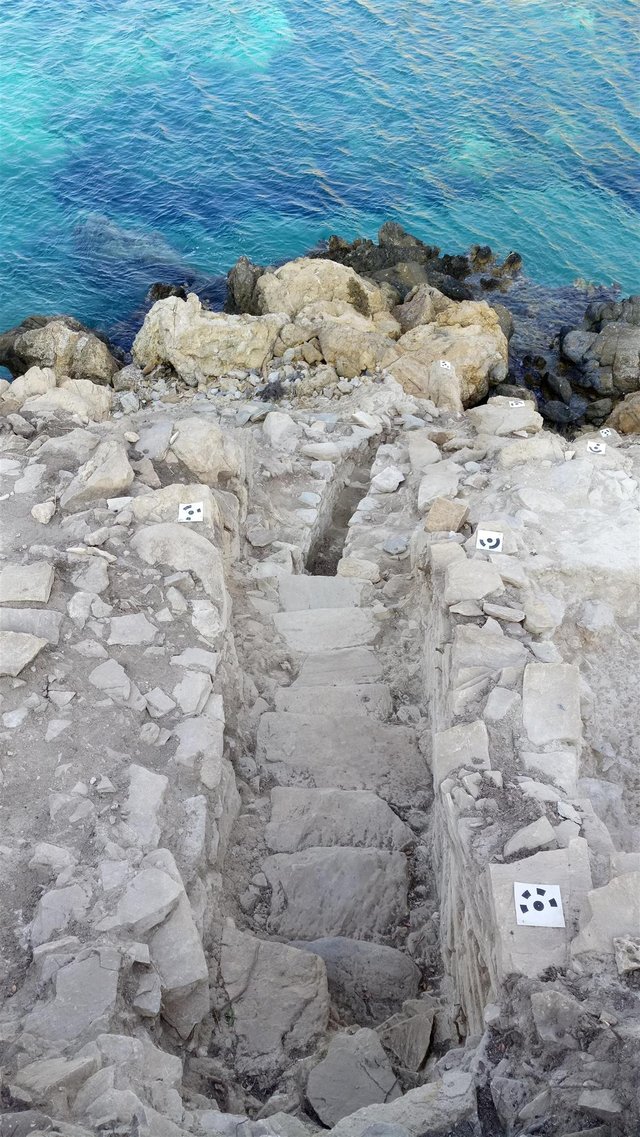Archaeologists have been surprised at the technical sophistication of a civilization that is 1,000 years before that of the Mycenaean palaces.
Stepped terraces
Stepped terraces excavated on the islet of Daskalio.
Daskalio is today an uninhabited island of the Cyclades archipelago (Greece), but formerly it was a promontory in the west of the island of Keros, linked to it through a narrow pass that disappeared due to the rise in sea level. The latest archaeological excavations in Daskalio have shown that this was a more imposing and densely occupied settlement than was previously believed, "one of the most impressive sites of the Aegean Sea at the beginning of the Bronze Age, in 3000 BC", As explained last week by the University of Cambridge, which has conducted the excavations with permission from the Ministry of Culture and Sports of Greece.
Stairs
Magnificent staircase excavated in the lower terraces.
Narrow passage
Ladder that led to the narrow passage that connected the promontory of Daskalio with Keros.
Ceramic containers
Ceramic containers that were used to store grain or oil.
The archaeological excavations are revealing the impressive appearance that Daskalio must have had: a series of terrace-like walls gave him the appearance of a stepped pyramid, and on each of these terraces stood some formidable structures of shining stone, as if all the Promontory was a great monument that emerged from the sea. After excavating a magnificent staircase in the lower terraces, archaeologists have been surprised by the technical sophistication of a civilization that is 1,000 years before that of the Mycenaean palaces. A sophisticated drainage system, which indicates that the architecture was carefully planned in advance, is being investigated to see if clean or residual water circulated there.
Seal
Ring that was used as a seal.
Marble figurine
Figurine of tiny marble.
Metallurgy, the most important new technology of the third millennium BC, seems to have been fundamental in Daskalio. The new excavations have brought to light two metallurgical workshops full of debris from metallurgy and other related objects. In one of the rooms, a lead ax with a mold used to make copper daggers has been discovered, as well as dozens of ceramic fragments, including those used to push the air into the fire and raise the temperature of the fire. At the end of the last excavation campaign an intact clay furnace appeared in another room indicating the existence of another metallurgical zone.
Mold
Mold to make a spear point or a dagger, copper or bronze.
Colin Renfrew
The British archaeologist Colin Renfrew, the co-director of the excavation, of the University of Cambridge.
FOLLOW ME: @desocrates

Helloo @desocrates
Me, @menulissejarah (writing history)
I see articles and photos on your post, have a historical, education, and cultural value of an area. This post is certainly very interesting to add insight in the field of history.
If you do not mind, I will resteem this post in my account. Thanks.
Date: January, 26, 2018
Helloo @desocrates
Saya, @menulissejarah (#menulissejarah)
Saya melihat artikel dan foto pada postingan milikmu, memiliki nilai sejarah, pendidikan, dan budaya suatu daerah. Postingan ini tentunya sangat menarik untuk menambah wawasan di bidang ilmu sejarah.
Jika kamu tidak keberatan, saya akan resteem postingan ini di akun saya. Terima kasih.
Tanggal: 26 Januari 2018
Downvoting a post can decrease pending rewards and make it less visible. Common reasons:
Submit
THANK YOU VERY MUCH FOR YOUR HELP ... AND THE TRUTH IS THAT WHAT IS STILL INTERESTING WHAT WE HAVE NEVER DISCOVERED, UNTIL WHERE THE HUMAN BEING ARRIVES WHEN THERE IS NOT IN HIS LIFE OR IN HIS THOUGHT ALL THE TEGNOLOGY WE HAVE NOW...
Downvoting a post can decrease pending rewards and make it less visible. Common reasons:
Submit
There is no past, then there will be no present. What has been done in the past will be seen in the present. The technology that exists today, is all due to some inventions that have been tried, done, and run in the past. But in the present, the technology is only developed. @desocrates
Downvoting a post can decrease pending rewards and make it less visible. Common reasons:
Submit